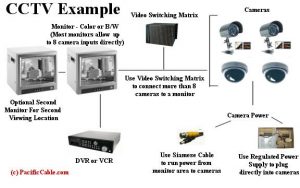A closed circuit Television camera setup goes a great deal in reducing crime in an area. Many thieves and burglars avoid stealing from an area when they see a CCTV installed. CCTV also acts as evidence of crimes and accidents happening in the area under surveillance and helps police track down the people causing the unfavorable incident.

Using a CCTV is simple but installing it is a bit complicated due to the various components it has. Only a person with knowledge about installation process should do it. A rookie may end up with faulty installation or a damaged camera. In this article, we will learn about the various components it has.
Security Camera:
The camera is the most important part of the CCTV. Regardless of the fact that whether you are buying a dome camera, bullet camera or PTZ camera, the specifications of the camera determines the output that you are going to get. You must carefully note the specifications of the camera like the type of image sensor, resolution of the camera, minimum illumination, shutter time, lens and angle of view and lens mount. These factors change the image quality as well as the coverage area of the CCTV to a great extent. It is always better to consult a CCTV installation professional regarding the type of camera you need for your specific purpose.
DVR:
Security DVR or Digital Video Recorder is at the heart of the CCTV installation. They receive, manage, store and record the video captured by the cameras. Not each DVR is the same. DVR comes in 4, 8 or 16 channel configurations. Each camera is connected to a channel. So it is important to buy the DVR with the right number of channels to support all your cameras. DVRs also vary in terms of recording speeds, compression, storage, and warranty. It is important to buy the DVR with a good warranty as CCTV is a long-term investment.
CCTV cable:
CCTV can be analog or IP based. Depending on that the cables can be RJ59 coaxial cable or CAT5/CAT6 RJ45 cables also known as ethernet cables. Cables connect the camera with the DVR as well as the DVR to the monitor. You can also find Siamese CCTV cables. Siamese cables contain an RJ59 coaxial cable that connects the camera to the DVR and an 18 gauge 2 conductor power cable that supplies power to the camera from the SMPS power supply.
BNC connectors/RJ45 connectors:
These connectors are fixed to the terminal positions of the cables and connect the cable to the camera as well as the DVR and monitor. Depending on the type whether the camera is analog or IP, RJ59 BNC connector or RJ45 connectors are used.
Power Supply:
CCTV power supply provides power to the cameras. They come in single, 4, 8,16 camera configurations and usually have the specification of 24 VAC or 24 VDC. The power supply is durable and easy to install.
